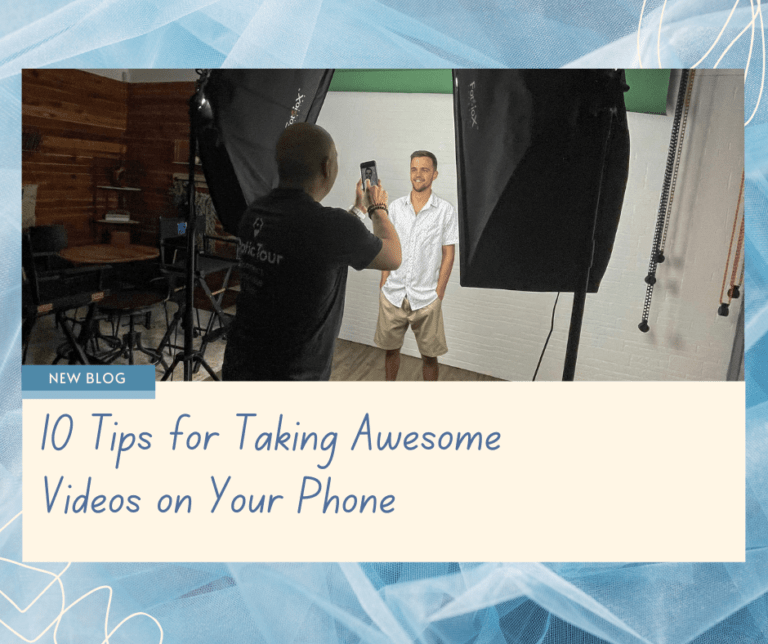10 Tips for Taking Awesome Videos on Your Phone
- By ramin
- June 10, 2021
- 2:48 pm

It seems like with a high-quality camera always slipped into our back pockets, we’d all be fantastic photographers and videographers.
And the reality is that you absolutely can be!
According to various studies by Techsmith, people watch videos because they’re genuinely interested in the topic at hand and because the content is relatable — not because the video contains tons of professional-style video footage or effects. And what’s more is only five percent of survey respondents said they stopped watching a video because the quality was poor.
So as long as you have something valuable to share with your audience, the bottom line is they’re really not going to care if you shot it on your phone — especially when today’s models have 4K camera capabilities and multiple lenses (meaning they’re already pretty high-quality cameras as it stands).
But before we get into some basic tips you can follow to shoot better videos on your phone, there’s an important note to be made here: There’s a big difference between a video you post on social media and one you use to garner solid leads from top business professionals. If the latter is what you’re looking for, you may want to turn to a professional video company to help you achieve your goals.
However, if you’re just looking to add the power of video to your digital marketing endeavors, then grab your phone, read this blog, and get to shooting your way to greatness.
Tip No. 1: Pay Attention to Lighting and Sound
Lighting is particularly important when it comes to shooting a video on your phone because a camera does not react to light the same way your naked eye does. In addition, lighting also allows you to set the mood and tone of whatever it is you’re filming.
When you have good, high-quality sound attached to your video, you’re able to seamlessly deliver information, evoke emotional responses, and solidify your messaging. But having bad audio will detract from the goal of your video and drive viewers away. Nobody wants to listen to a bunch of staticky crackles, after all.
For best results, choose a well-lit, relatively quiet space to shoot your video and an additional phone to capture your audio (even if you don’t end up using it, it’s incredibly important to have a backup).
Unless you have a solid lighting setup, you likely won’t want to shoot at night, as there’s a significant dip in quality. (But if you absolutely have to shoot when the stars are out, here are some basic tips for taking videos at night.)
Tip No. 2: Wear Something That Makes You Feel Comfortable and Confident
If you’re going to be on camera, the truth is that you don’t need to look red-carpet ready to give a noteworthy performance. You’re going to look great in whatever you wear, anyways — but if your clothes don’t fit or feel right, that’s going to show through in your body language, facial expressions, and tone of voice.
By focusing on wearing clothes that make you feel comfortable and confident, you’ll prime yourself for appearing, acting, and sounding that way in front of the camera.
Swap the stilettos for shoes with more support. If you want to say yes to the dress, wear one that’s loose and comfy instead of tight and restricting. Try wearing a nice button down or a company T-shirt in place of a three-piece suit. (Unless, of course, you’re shooting a fashion video. If that’s the case, feel free to dress to the nines!)
Just make sure that whatever you wear doesn’t have any busy patterns or slogans as these can appear blurry and wavy on screen and distract your viewers. Remember: The focus should be on you, not on your outfit.
Tip No. 3: Keep It Steady
Shaky videos, in short, are hard to watch. Your viewers want to be guided smoothly along the path you’re trying to take them — not twisted and jolted into wanting to run the other way.
For best results, use a tripod. There are tons of cheap options on Amazon, but if you aren’t willing to spend the money, take a look at these DIY tripod alternatives.
Tip No. 4: Employ the Rule of Thirds for Good Framing
You know a solid shot when you see one — but did you know there’s a set of rules you can follow to ensure that every shot you take is a great one?
That’s right — the rule of thirds!
The rule of thirds is essentially just a guideline that proposes that an image should be divided into nine equal parts by equally spaced horizontal and vertical lines with the focal point of the photo landing on the intersection of said lines.
Here’s a picture to put it all into perspective:

See how the focal point — the feather boa — lines up perfectly with the intersection in the top right-hand corner?
Studies have shown that when viewing images, our eyes naturally fall along these points of intersection — not in the middle like you might expect. By placing your focal points along these intersections, you create balance, flow, and allow your viewer to interact with your photo more organically.
And the best part is that your phone already has a built in rule-of-thirds grid!
But you know what they say about rules… and it’s that they’re made to be broken.
Yes, it’s okay for you to break the rule of thirds. There are tons of striking videos out there that are centered and symmetrical that don’t employ the use of the rule of thirds. However, if you’re looking for a simple and easy way to get started on understanding what goes into good framing, give the rule of thirds a shot.
Tip No. 5: Play Around With Built-In Features
Your phone likely has tons of built-in features for you to make your shots cleaner, clearer, faster, or slower. Before you go on set, try your hand at taking timelapses, slo-mo videos, and employing the use of auto-exposure and auto-focus tools.
Once you become comfortable with these features, you’ll drastically change what your phone is able to do for you.
Tip No. 6: Watch How You Hold Your Phone
No, we’re not just talking about making sure your lil fingies aren’t blocking the lens — we’re talking about the difference between landscape and vertical shots.
If you’re taking a video for your Instagram story or TikTok channel, then yes, by all means, shoot vertically. But if you plan to do anything else, then you’ll likely want to shoot in landscape.
Scientifically speaking, our vision allows us to obtain more information when we view it left to right rather than up to down — so don’t risk driving off your viewers with the wrong video orientation.
Tip No. 7: Decide When to Use the Front-Facing or Rear-Facing Camera
Your front-facing camera might have lower quality than your rear-facing one, but it also offers an innately more personal feel to your content.
If you’re looking to add an additional level of humanity to your company videos, then consider using your front-facing camera. This is especially great for shooting product reviews, testimonials, and behind-the-scenes content with your clients, staff, and more.
Tip No. 8: Be Mindful of the Zoom
Depending on the type of phone you have, zooming in before shooting your shot makes the quality of your footage drop quite a bit.
In addition, zooming in too far can also make your footage particularly shaky because your phone will pick up more of your precise movements.
For best results, don’t hesitate to get up close and personal with your subjects, and just be mindful of the fact that your footage might not come out as clean if you decide to zoom in.
Tip No. 9: Make Use of Built-in Editing Tools
Your phone will likely have some built-in editing tools to help you make basic edits to your videos, like cropping, trimming, and basic color correction. Familiarize yourself with these so you can make the finished product even stronger!
If you use an iPhone in particular, there’s also a built-in application called iMovie: a free video-editing software where you can add titles and text, transitions, filters, and so much more. This is a simple and easy way to jazz up your footage without needing to find a video editor to take care of things for you.
Tip No. 10: Kick Back, Relax, and Be Yourself
Your viewers are here to learn about you, your company, your products, and your goals. As such, being yourself is the best possible thing you can do to provide that for them.
Imagine you’re meeting an old friend for coffee. That’s exactly how you should sound when you’re on camera — calm, casual, and conversational.
Think hard about what makes you most relaxed, and try to do a few of those things before your shoot. Whether it’s sipping on a nice cup of tea or listening to your favorite album, putting yourself into a peaceful state of mind before you go on camera will set you up for success.
Moving Forward
Now that you’re ready to take videos on your phone like a professional videographer, you’re now able to share valuable information with your audience in a way that really resonates, draw more engagement and interaction to your pages and platforms, get more leads, and close more sales — and all with that tiny electronic rectangle we carry around in our back pockets.
But if you still think you could use a little guidance in creating effective videos for your digital marketing plan, our team at OpticTour would love to lend a hand!
Whether it’s a compelling educational video or sharing a client’s journey, our goal is always to connect you to your viewers on a deeper, more lucrative level.
With the incredible power of OpticTour’s video producers, editors, and animators, we’ll help you build relationships with current and target audiences, provide a visually striking rendition of your company, generate leads, and leverage your video alongside other digital-marketing tactics to maximize its potential — and yours.
Whenever you’re ready, you can schedule your free consultation with us by filling out this contact form.

© 2021 OpticTour. Trademarks and brands are the property
of their respective owners.
Google and the Google logo or any other related screenshots are registered trademarks of Google LLC, used with permission.
